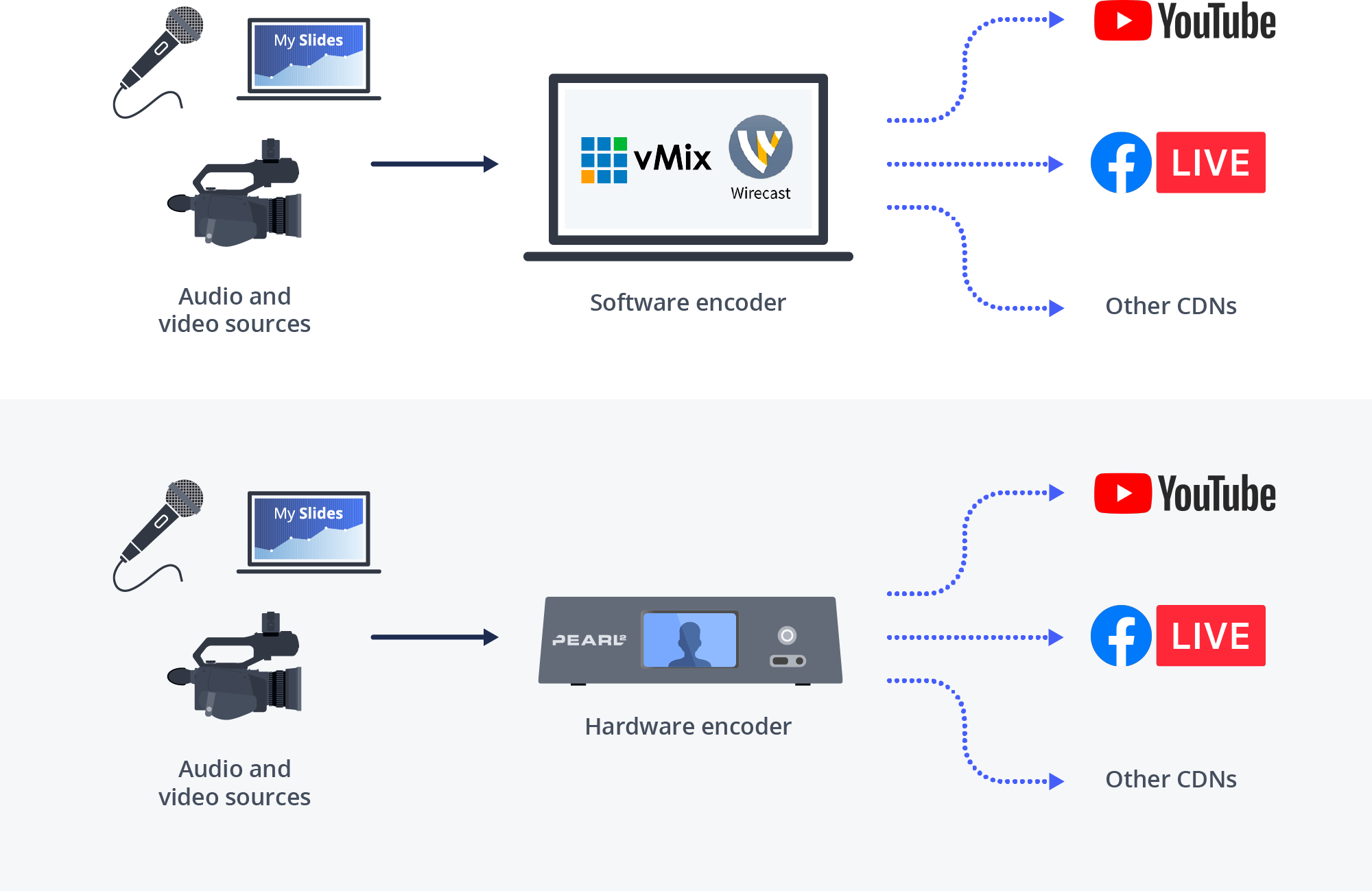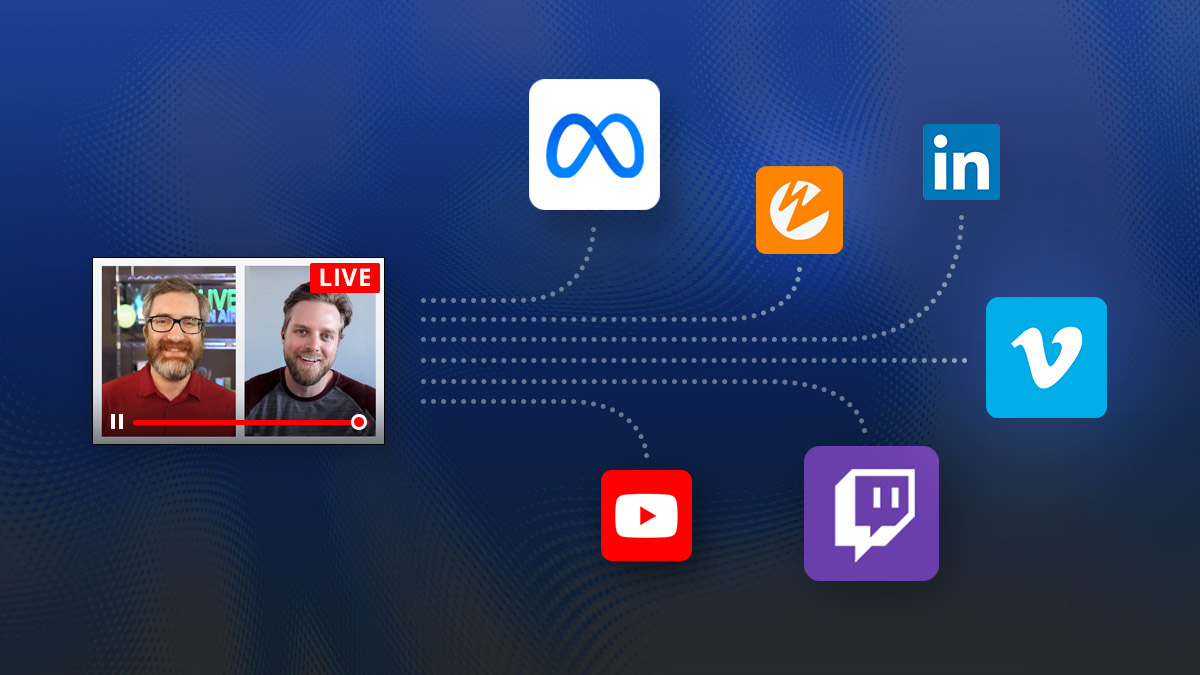Not sure if YouTube, Facebook Live, LinkedIn, or another website altogether is the best place to host your live stream? There’s no need to choose: that’s what simulcasting is for.
If you want your content to reach more people (like every streamer out there), simulcasting can help you there, too. Of course, it’s a bit more complicated than that. Read on to gain a full understanding of what simulcasting is and how simulcasting works.

Share your video far and wide
Epiphan Pearl hardware encoders support simulcasting, offering the processing power to stream to multiple destinations at once. Tight on bandwidth? Pearl works with cloud-based multistreaming services like Restream, Switchboard Live, and StreamShark.
Discover Epiphan solutionsWhat is simulcasting?
Simulcasting refers to the streaming of recorded or live video to multiple websites or platforms at once. It’s a blended word (or a portmanteau, if you want to get fancy) that combines the terms “simultaneous” and “broadcasting.”
Whereas before simulcasting was used exclusively within the realm of radio and television, these days it’s more common to hear it in the context of streaming. It’s still used today in reference to TV and broadcasting (which is why “multistreaming” is the more precise term). But for the purposes of this blog, we’ll be discussing simulcasting in the streaming context – to mean the sending of video and audio content to multiple destinations at once, whether that includes social media platforms, one or more custom RTMP destinations, or your own website.
Benefits of simulcasting
Why simulcast? There are some pretty compelling reasons:
- Reach new audiences: Streaming your stuff to multiple platforms boosts discoverability and can earn you fresh followers.
- Give your existing audience a choice: If your viewers want to tune in on YouTube rather than Facebook, why not give them that option?
- Stretch your content further: Many video platforms will auto-publish streamed video as on-demand content, helping you build up a video content library across multiple channels.
- Leverage the features of multiple platforms at once: For example, you could put your content behind a paywall using a platform like Vimeo while streaming simultaneously to an unlisted YouTube link for easy sharing with colleagues.
- Reap extra analytics: Get a better sense of the demographics and proportion of your audience on different platforms.
How to simulcast
There are many different ways to simulcast your content. These can be grouped into two broad categories:
- Simulcast via an encoder
- Simulcast using a cloud-based platform
Simulcast via an encoder
Encoders capture, compress (encode), and deliver audio and video data to a destination, whether that’s a social media platform or your own website. There are two types: hardware encoders and software encoders. If you’re not clear on the differences (and they’re important), check out our blog on hardware vs. software encoding.
(Need a hardware encoder? Check out our Pearl family of dedicated appliances. And if you’re searching for a software encoder, be sure to start with our list of the best streaming software.)


Live streaming hardware encoder primer
Read moreWhether you’re using a hardware encoder or a software encoder, simulcasting is generally accomplished the same way. Here again there are two options:
- Create multiple RTMP push destinations
- Encode multiple streams separately
Which is best will come down to the target bitrates of your streams (i.e., are they all the same, or are they different?) and your encoder’s processing power.
Create multiple RTMP push destinations
Streaming software or dedicated appliances that support multistreaming will let you define multiple destinations for your content. For each streaming destination, you’d need to supply a URL, a stream key, and, if applicable, a username and password.
There’s an important caveat with this method, and that’s the required bandwidth for streaming. For each stream you’re sending out, take the combined video and audio bitrates, add them all up, and multiply that figure by 1.5. That’s how much upload headroom you’ll need to ensure smooth streaming.
Encode multiple streams separately
This is the way to go if you’re sending content to multiple destinations with different encoding settings. For example, you could send a 4K stream to YouTube and the same content in 720p to Facebook.
Most streaming platforms publish recommended encoding settings. You can find these pretty easily on Google (for example, here are YouTube’s recommended encoding settings). Whenever you’re planning to simulcast, you’ll want to take these recommendations into account and configure each stream according to its target destination.
An additional caveat here is that this approach will add to your encoder’s processing load. How many outbound streams you can push will come down to your system’s specs. For example, Pearl-2 supports up to six simultaneous HD encodes.
Simulcast using a cloud-based platform
Short on bandwidth? Services like Restream and Switchboard Live make it so you’re only sending out a single outbound stream, with all the duplication done on the platform side. For example, rather than setting up multiple RTMP push destinations on Pearl-2, you could tune Pearl to a platform-provided RTMP, eliminating the load at the encoder level and on your bandwidth.

This does add a bit of latency. How much latency depends on the service you’re using. Generally, it’s minimal.
StreamShark takes this concept further by offering tons of options for customization. For example, you can embed a branded player on your website, and set up pre-roll and post-roll footage at the platform rather than encoder level. There’s even a custom firmware for Pearl encoders that strengthens encoder management through StreamShark.
The perfect solution for simulcasting
Epiphan Pearl hardware encoders can stream to multiple destinations at once and work with cloud-based multistreaming services like Restream, Switchboard Live, and StreamShark. Intuitive controls and user-friendly interfaces make simulcasting simple whether you’re using a Pearl Nano, Pearl Mini, or Pearl-2.
To learn more about Pearl and our other products and services, check out our index of Epiphan solutions.
